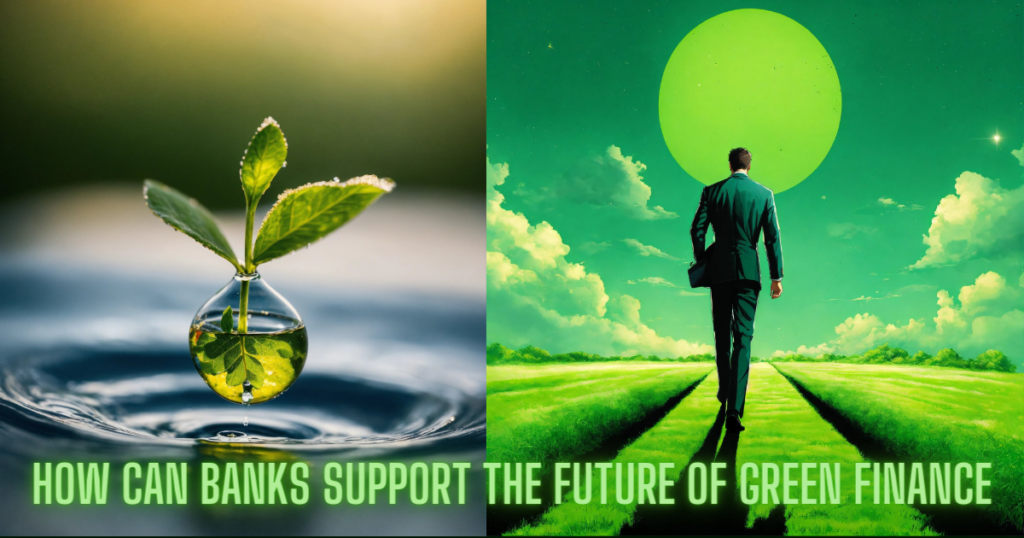Introduction:
Green finance, a transformative approach to financing, revolves around projects and initiatives with positive environmental and social impacts. This includes efforts to reduce greenhouse gas emissions, champion renewable energy, preserve biodiversity, and foster social inclusion. As custodians of substantial financial resources, banks play a pivotal role in steering the trajectory of green finance. In this blog post, we will explore 15 strategies for banks to actively contribute to and support the future of green finance.

Future of Green Finance-15 strategies for banks
- 1. Green Lending Policies:
- 2. Diverse Green Financial Products:
- 3. Innovation and Collaboration:
- 4. Cultivating a Green Culture: Future of Green Finance
- 5. Green Financial Education: Future of Green Finance
- 6. Specialized Green Lending Programs:
- 7. Sustainable Investment Portfolios:
- 8. Green Bonds Issuance: Future of Green Finance
- 9. Enhanced Due Diligence: Future of Green Finance
- 10. Educational Initiatives and Collaboration:
- 11. Innovation in Financial Products:
- 12. Carbon Footprint Tracking for Businesses:
- 13. Employee Incentives for Sustainable Practices:
- 14. Customer Engagement: Future of Green Finance
- 15. Risk Management for Climate Change:
- Conclusion: Future of Green Finance
- People Also Ask about Future of Green Finance
- Disclaimer
1. Green Lending Policies:
Green finance journey begins with the formulation of robust green lending policies. These policies, aligned with global standards like the Green Bond Principles and Equator Principles, enable banks to identify, assess, and manage the environmental and social dimensions of their lending activities. Transparency is key, with banks disclosing their performance and impact to stakeholders.
2. Diverse Green Financial Products:
Banks can champion green finance by offering a diverse array of financial products that cater to the preferences of environmentally conscious customers. From green loans and mortgages to green bonds and deposits, these products come with enticing incentives such as lower interest rates, tax benefits, and carbon credits, encouraging customers to embark on green projects.
3. Innovation and Collaboration:
Embracing green innovation is paramount. Collaborating with regulators, policymakers, investors, rating agencies, NGOs, and academia fosters an ecosystem that supports the development and adoption of new green technologies, methodologies, and standards. Banks can leverage their resources and networks to play a pivotal role in shaping the future of green finance.
4. Cultivating a Green Culture: Future of Green Finance
Banks should take a proactive stance in cultivating a green culture within their organizations. Through training, education, and effective communication, employees can be empowered to integrate green finance principles into their daily operations. Furthermore, integrating green criteria into performance evaluations and reward systems encourages a commitment to sustainability.
5. Green Financial Education: Future of Green Finance
Education forms the bedrock of green finance advocacy. Banks can take the lead in educating their stakeholders – employees, customers, suppliers, and communities – about the significance of green finance. By organizing workshops, webinars, and outreach programs, banks contribute to a more informed and environmentally conscious society.
6. Specialized Green Lending Programs:
Introducing specialized lending programs dedicated to environmentally friendly projects is an impactful strategy. By providing favorable terms for loans related to renewable energy, energy efficiency, and sustainable agriculture, banks encourage businesses to align their operations with sustainable practices.
7. Sustainable Investment Portfolios:
Banks can curate sustainable investment portfolios, directing capital towards environmentally sustainable and socially responsible companies. Offering investment options that prioritize green initiatives enables customers to contribute to positive environmental change while securing financial returns.
8. Green Bonds Issuance: Future of Green Finance
Facilitating the issuance of green bonds is a direct way for banks to raise capital for eco-friendly projects. Green bonds, with proceeds earmarked for sustainable initiatives, attract investors seeking ethical investment opportunities and contribute to the growth of the green finance market.
9. Enhanced Due Diligence: Future of Green Finance
Strengthening due diligence processes ensures that banks thoroughly assess the environmental impact of potential clients and projects. By integrating comprehensive risk assessments, banks minimize exposure to environmentally detrimental ventures, reinforcing their commitment to sustainability.
10. Educational Initiatives and Collaboration:
Collaboration with NGOs and government bodies enriches the impact of green finance initiatives. Banks can collaborate on educational programs that raise awareness about environmental issues, fostering responsible financial behavior and advocating for supportive policies.
11. Innovation in Financial Products:
Banks can innovate in financial products, introducing green mortgages and insurance policies. This not only aligns with sustainability goals but also incentivizes individuals and businesses to adopt environmentally friendly practices in real estate and insurance.
12. Carbon Footprint Tracking for Businesses:
Offering tools and services to help businesses track and reduce their carbon footprint is instrumental. This could involve providing software solutions or consultancy services to clients interested in improving their environmental performance.
13. Employee Incentives for Sustainable Practices:
Implementing incentive programs for employees who contribute to and promote sustainability initiatives creates a positive feedback loop. Recognizing and rewarding green innovations or meeting sustainability targets fosters a culture of environmental responsibility within the organization.
14. Customer Engagement: Future of Green Finance
Actively engaging with customers to understand their preferences for sustainable banking products and services is crucial. By tailoring offerings to meet customer expectations, banks strengthen their relationship with environmentally conscious clients and build a loyal customer base.
15. Risk Management for Climate Change:
Integrating climate-related risk assessments into overall risk management strategies is a forward-looking approach. Identifying and mitigating financial risks associated with climate change ensures that banks are resilient in the face of environmental shifts.

Conclusion: Future of Green Finance
In conclusion, the future of green finance rests in the hands of banks willing to embrace sustainability as a core principle. By developing comprehensive green policies, fostering innovation, and collaborating with various stakeholders, banks can actively contribute to a more sustainable and environmentally conscious financial landscape. Through these concerted efforts, banks can not only mitigate environmental risks but also play a catalytic role in driving positive change on a global scale.
People Also Ask about Future of Green Finance
Q. What is the future of green banking?
The future of green banking is promising and pivotal for sustainable development. Green banking involves financial institutions integrating environmental and social considerations into their operations. As the global focus on environmental issues intensifies, the future of green banking will likely see increased innovation in sustainable financial products, stringent adherence to green lending policies, and a growing commitment to transparent reporting of environmental performance. Banks are expected to play a crucial role in financing renewable energy projects, supporting eco-friendly initiatives, and contributing to the transition to a low-carbon economy.
Q. How banks and financial institutions may support the green economy?
Banks and financial institutions can support the green economy through various initiatives:
Green Lending and Investments: By offering financial products and services that prioritize environmentally sustainable projects, such as green loans, green bonds, and sustainable investment portfolios.
Innovation in Financial Products: Developing innovative products like green mortgages, green insurance, and other financial instruments that incentivize and reward sustainable practices.
Collaboration and Partnerships: Engaging in collaborations with regulators, policymakers, NGOs, and other stakeholders to foster a supportive ecosystem for green initiatives and policies.
Educational Initiatives: Conducting educational programs to raise awareness among employees, customers, and the public about the importance of sustainable finance.
Transparent Reporting: Implementing transparent reporting practices on the environmental and social impact of their activities, demonstrating accountability and commitment to sustainability.
Q. How can banks support sustainability?
Banks can support sustainability through a multifaceted approach:
Green Financing: By actively promoting and financing projects that have a positive impact on the environment, such as renewable energy, energy efficiency, and sustainable agriculture.
Green Product Offerings: Introducing a range of green financial products, including green loans, green bonds, and sustainable investment portfolios, to meet the demands of environmentally conscious customers.
Internal Culture and Practices: Fostering a green culture within their organizations through employee training, integrating green criteria into performance evaluations, and implementing sustainable business practices.
Collaboration with Stakeholders: Collaborating with governmental bodies, NGOs, and other stakeholders to contribute to the development and adoption of sustainable policies, technologies, and practices.
Risk Management for Sustainability: Integrating sustainability considerations into risk management practices to identify and mitigate potential environmental and social risks associated with banking activities.
Disclaimer
This article has been created on the basis of internal data, information available publicly, and other reliable sources to be believed. The article may also include information which are the personal views/opinions of the authors. The information included in this article is for general, educational, and awareness purposes only and is not a full disclosure of every material fact.
All the information on this website i.e. World Virtual CFO – is published in good faith and for general information purposes only. World Virtual CFO does not make any warranties about the completeness, reliability, and accuracy of this information. These are my views for only information purposes. Any action you take upon the information you find on this website (World Virtual CFO), is strictly at your own risk. World Virtual CFO will not be liable for any losses and/or damages in connection with using our website. For details please refer to our disclaimer page.
Dr. Dinesh Sharma is an award-winning CFO and AI strategist with over two decades of experience in financial leadership, digital transformation, and business optimization. As the founder of multiple niche platforms—including WorldVirtualCFO.com—he empowers professionals and organizations with strategic insights, system structuring, and innovative tools for sustainable growth. His blogs and e-books blend precision with vision, making complex financial and technological concepts accessible and actionable.
2 thoughts on “How can Banks Support the Future of Green Finance: Know now”